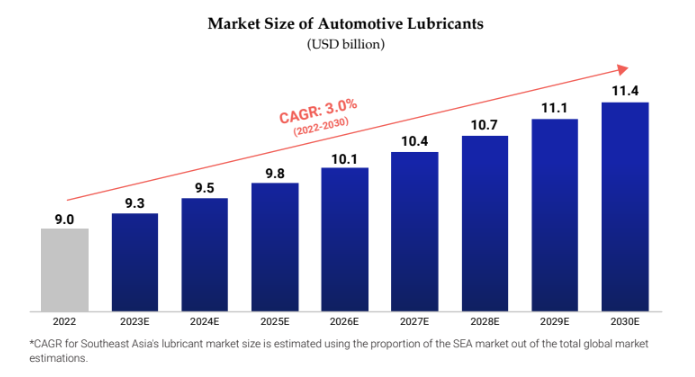

The market size for automotive lubricants in Southeast Asia (SEA) is on a steady rise, driven by various factors that underscore the region's burgeoning automotive industry. With increasing passenger vehicle ownership, rapid industrialization, and a growing emphasis on high-quality maintenance, the demand for automotive lubricants will soar in the coming years.
Countries like Indonesia and Vietnam are witnessing strong traction in commercial vehicles due to rapid industrialization and infrastructure development. Additionally, consumers are increasingly willing to invest in high-quality products to ensure the efficient functionality of their machinery and vehicles.
In response to these favorable trends, major lubricant companies such as Shell, Chevron, and Petronas are strategically leveraging digitalization within their supply chains and bolstering their online presence to stay competitive. This led to the market growth of automotive lubricants in SEA, which commands a significant 60% total market share in the region's lubricants market.
The market growth of automotive lubricants in SEA is supported by diverse industry segments, including specialized products such as engine oils, transmission fluids, and gear oils tailored to meet the unique requirements of automotive and industrial applications.
In 2022, the automotive lubricant sector in SEA boasted a substantial market size of USD 9 billion, with projections indicating a further increase to USD 11.4 billion by 2030. The compound annual growth rate (CAGR) of the automotive lubricant industry from 2022 to 2030 is estimated to be around 3%. This growth trajectory underscores the region's promising automotive lubricant market landscape and its potential for sustained expansion in the foreseeable future.

Image Source: YCP White Paper
Current trends in the automotive lubricant market in SEA include the significant impact of government policies, such as removing import taxes for cars imported from the ASEAN region. This policy change has reduced new car prices, driving increased car sales and increasing the demand for lubricants.
However, the rising adoption of electric vehicles (EVs) poses a notable challenge for lubricant companies in SEA. Nations like Singapore and Thailand are witnessing an upsurge in EV adoption, necessitating lubricant manufacturers to adapt their product offerings and strategies to meet the evolving needs of these vehicles.
Moreover, there is a burgeoning demand for specialized lubricants for commercial vehicles, including trucks, buses, and agricultural equipment. This demand is particularly pronounced in Indonesia and Vietnam, propelled by their flourishing transportation sector and expanding agricultural industry.
As emerging economies in SEA continue their developmental trajectory, there is an anticipated shift towards synthetic lubricants. Consumers are increasingly cognizant of the long-term cost benefits and superior engine protection offered by high-quality synthetic lubricants, fostering a growing preference for these products.
Regarding distribution, retail shops, service centers, and gas stations remain the dominant channels for automotive lubricant sales in SEA. These channels provide convenient access to lubricant products for vehicle owners across the region, contributing to sustained market growth.
Despite the challenges posed by the burgeoning EV market, the automotive lubricant industry in SEA is poised for continued growth. By leveraging digitalization within their supply chains and fortifying their online presence, lubricant companies can stay competitive and capitalize on emerging opportunities in the region's automotive sector.
Source: https://ycpsolidiance.com/white-paper/SEA-automotive-lubricants

Revolutionizing Finance: An Overview of Digital Lending in Southeast Asia
Digital lending is poised to become the primary revenue driver for digital financial services in Southeast Asia (SEA) by 2025, outpacing digital payments. This growth is fueled by a 33% annual increase in digital lending, supported by technological innovations such as automated loan origination processes and seamless integration of financial services into digital experiences. These advancements have made it easier for consumers to access financing for various needs, including online shopping, travel bookings, and ride-hailing services.

IoT Integration in the SEA Automotive Lubricants Market
The Southeast Asia (SEA) automotive lubricants market is rapidly evolving with the integration of Internet of Things (IoT) technology. This transformation offers significant benefits, creates new opportunities in smart technology, and introduces innovative IoT solutions that can revolutionize the industry.

Embracing Robotization: Challenges and Opportunities in Industry 4.0
Robotization presents challenges and opportunities for businesses and the workforce, requiring companies to embrace this transformation.

Opportunities in the Indonesian Skincare Market
The rapid growth of the Indonesian skincare market presents significant opportunities for the beauty industry. Projections indicate a steady growth trajectory of 4.6% over the next five years, reflecting sustained consumer demand and market expansion. In this article, we will explore the various opportunities that the Indonesian skincare market presents for brands seeking to establish a strong foothold and thrive in this dynamic landscape.